Women and alpinism: a narrative about climbing in South America
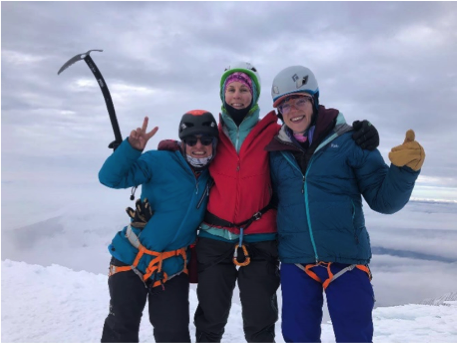
Written by Emily O’Dean, Women’s Ecuador Expedition member
“Oh, should I have given you a hug up there?” the trip leader asked as I cried into the arms of man who had hiked up to meet us from base camp as we hiked down from high camp. The three of us stood in the middle of a snow-covered talus field at 17,000 feet of altitude in Bolivia. I gasped for more oxygen between my sobs.
Over the past few days, I had made a quick ascent from 12,000 foot trailhead to the 18,000 foot base camp with four of the men in our seven-man one-woman unguided team. The five of us who moved up to high camp moved ahead of schedule – but we felt strong as we passed base camp, and thought we could fit in a few more ascents of mountains in the area if we skipped our acclimatization schedule on the mountain.
I felt like the “odd woman out” from the beginning of the expedition. I was certainly used to climbing with men – in fact, all of my mountain educators had been men, from my first semi-pro rock climbing boyfriend who taught me to tie a figure-8 to the men in a local mountaineering club who showed me how to step into my crampons and use my axe to self-arrest. However, being on a 3-week expedition with all men felt different than a 3-day push of Casaval Ridge. I soon learned that the support, vulnerability, and emotional connection that I could forgo on a quick weekend trip were a necessity for me on a high-altitude high-stakes mountain.
As we prepared our gear and explored La Paz, I tried to keep up with the rapport – which consisted of bouncing between political debates, intellectual musings about physics and philosophy, and poop jokes. As I conversed with the men, it was clear that I wasn’t actually getting to know any of them on a personal level, and certainly didn’t feel comfortable sharing much of myself.
A dynamic of subtle competition emerged as we began our hike to our first camp on the mountain. Several of the men raced from the trailhead to our first camp in half of our anticipated time. I hurried alongside them, wanting to be strong, but not fully understanding the repercussions of performing above my anaerobic threshold. Soon I became part of the “fast group,” and we raced up to high camp to try to tackle multiple summits in a short weather window. At our group dinner, we discussed how we felt in terms of our physicality – we felt “strong,” we felt “good,” but we never touched on how we felt mentally. I was nervous and unprepared. I was unsure of my own physical and mental competency. I decided that I needed to be strong, independent, and quiet if I was going to get through this.
After our quick ascent to high camp, I felt ill. We sprinted up from base camp to 18,000 feet, and my head was reeling. I kept it to myself as the men in the group worked on recon and planned for the summit. The conversation as we prepared for our 4AM summit bid was light and surficial. I tossed and turned trying to sleep before the sun set and I wondered why I was there. Why did I put myself through this pain to keep up with men who I didn’t relate to, and who I didn’t even feel comfortable telling that I was sick? When the headaches and nausea worsened to an almost unbearable point in the night, I finally told my tent mate that I was experiencing some AMS (acute mountain sickness). When we gathered for breakfast before the summit bid my head pounded so much that I could barely speak, and the men discussed whether I could head down alone while they attempted their summit bid.
Finally it was decided that the trip leader would walk me half way down to base camp, and a member of the “slow team” would hike up from base camp and meet us mid-mountain to escort me the rest of the way. The rest of the team at high camp would go for the summit. I felt mentally numb through the physical pain. I had no choice but to be tough and get through this.
When the man from base camp reached us mid-mountain, he opened his arms and pulled me into a hug. I burst into tears. This was the first act of emotional support, physical touch, and empathy that I had received since I had flown into the country a week prior. Everything that I had been keeping to myself – my anxiety, loneliness, feelings of inadequacy, and disappointment at my altitude sickness – all of it came rushing out as I received support in that moment.
In the months after the expedition, I questioned my ability to climb big mountains and my motives for doing so. I also questioned my climbing partners, and began to seek out the qualities of openness and vulnerability as well as technical skills in potential partners. I felt skeptical of climbing with many of the men that I had previously climbed with when I returned home, and struggled to find female mountaineering and ice climbing partners.
I focused on climbing in my home mountains of the western United States as the next years passed. The majority of my climbing partners remained men. I often invited my female rock climbing friends on introductory mountaineering trips – but the sport didn’t stick for any of them. I knew that there were like-minded women out there, but I also knew that the barrier to entry was higher for women. Like me, most women learn alpine skills from men. In 2018, less than 2% of IFMGA guides were women1. While several commercial guiding companies offer women’s only introductory mountaineering courses, there are few (or none) that offer progressive courses and expeditions to intermediate and advanced women climbers.
As I became a stronger climber physically, I also developed a strong personality as a climbing partner. I engaged in conversations about gender, inequality, and mental health in mountain sports with every person I climbed with. If people weren’t open to these conversations, I might still go out on single pitch crag days with them, but they were out as partners for longer alpine missions.
The next several years, as my interests and climbing skills developed, I felt ready to attempt another high-altitude expedition. This time I wanted to do things as safely as possible, so I contacted Alpenglow Expeditions to talk about next steps. I head learned about Alpenglow from following one of the founders, Adrian Ballinger, on social media. I had always appreciated his openness and candor about safety and risk in the mountains, and friends who had traveled with Alpenglow highly recommended their guides. In my first conversation with the office, I expressed interest in going to climb an intermediate peak in Ecuador or Peru. I also told them that I wanted to make sure that there would be at least one other woman on the trip.
 What happened from there over the next few months was a collaboration that I never expected from a
What happened from there over the next few months was a collaboration that I never expected from a
busy commercial guiding company. The office team and I began discussions of how we could build a trip
that not only included one other woman, but would be all-women and more technical than just the
regular mountain school introductory climbs. Alpenglow proposed Carla Perez as the lead guide, and
immediately I was all-in. I had followed Carla on social media for a few years since her Everest and K2 ascents without oxygen in 2016 and 2019. I had looked up to her for years not only for her incredible climbing ability, but also her amazingly positive attitude that was evident in the “Breathtaking: K2” Eddie Bauer film. She obviously loved the mountains, and that joy was contagious even through the screen.
Alpenglow proposed the expedition to Carla while she was climbing Dhaulagiri, and over the next few
weeks she came up with an exciting itinerary in Ecuador that included El Altar, the most technical mountain in the country, and a traverse of Chimborazo’s four summits, the highest mountain in
Ecuador.
From the moment I met Carla at the Quito airport, I knew that this expedition would be different than my last. She greeted me and the other client, Taylor, with a warm smile and big hug. In route to our first acclimatization peak, we immediately jumped in to conversation about our motivations for climbing, setbacks that we had experienced in the past, and moments that we had felt looked down upon because we were women. From those first moments we began developing trust in one another, not only as we checked each other’s tie-in knots and belay techniques, but as we talked openly and honestly about our goals, hopes, and fears for the trip and for our climbing careers as a whole. Conversation with the group came easily and I found that we were able to transition seamlessly from talking about our past climbs, to politics, to families and relationships, to how to pee in a pot when it’s too cold to leave the tent. There was a level of comfort, support, and vulnerability that developed early on that I simply hadn’t experienced before with male climbers.

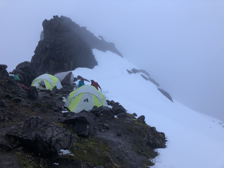
Our first climb on the list was El Altar, which included 4,500 vertical feet of the most beautiful/horrible hiking in knee-deep mud to reach the Italian Camp set just below our routes. About an hour from camp we got a few minutes of breathtaking views of the mountain’s 9 summits, 3 of which we were scheduled to climb. That would be the last time we would see the mountain.
That night white-out conditions set in, and didn’t let up the next day. Everyone stayed positive between card games in the tent, delicious food provided by our camp cook every few hours, and regular deliveries of hot chocolate with coconut milk. Carla discussed our options, and we decided to head down the following day when the weather didn’t let up. Instead of leaving defeated, we left with the excitement of getting to someday return to El Altar.
 Given our early exit, Carla worked with the Alpenglow office to pivot our goals towards another acclimatization peak, and soon we were on our way to Cotopaxi, the tallest active volcano in the world. While this climb isn’t technical, it was an opportunity for myself and Taylor to reach our new personal high points. Our wake-up time was 10PM and we all gathered to have a hot breakfast before beginning our climb. A few hours into our climb, I started to feel sick, and expressed this to the group. The support I felt was instantaneous – we stopped and took a break, ate and drank, and everyone continued to check in with me as we moved on. Within a few minutes of fueling I felt great, which spurred a discussion about how important nutrition is for us as female climbers (a lesson I continued to learn throughout the trip).
Given our early exit, Carla worked with the Alpenglow office to pivot our goals towards another acclimatization peak, and soon we were on our way to Cotopaxi, the tallest active volcano in the world. While this climb isn’t technical, it was an opportunity for myself and Taylor to reach our new personal high points. Our wake-up time was 10PM and we all gathered to have a hot breakfast before beginning our climb. A few hours into our climb, I started to feel sick, and expressed this to the group. The support I felt was instantaneous – we stopped and took a break, ate and drank, and everyone continued to check in with me as we moved on. Within a few minutes of fueling I felt great, which spurred a discussion about how important nutrition is for us as female climbers (a lesson I continued to learn throughout the trip).
Towards the top of the mountain, I began to have severe nerve pain in my back. As soon as I brought this up, Carla and Taylor both offered to carry some of my loads. My first reaction was that I didn’t want to burden anyone else, but Taylor reminded me “this is a team sport – let us help you.” So often in alpinism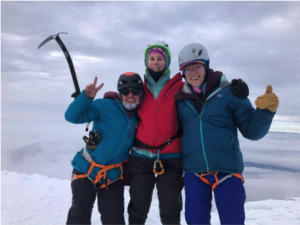 and mountaineering we think about ourselves as individuals when we’re not tied in to a rope. In the media, individuals reach summits and make records – not teams. These words from my teammate stuck with me, both in terms of how I contributed to the group and my willingness to let others help me throughout the rest of the trip. We were a team, and we were working together on our objectives. We all summited Cotopaxi together that morning – the first summit for our women’s team.
and mountaineering we think about ourselves as individuals when we’re not tied in to a rope. In the media, individuals reach summits and make records – not teams. These words from my teammate stuck with me, both in terms of how I contributed to the group and my willingness to let others help me throughout the rest of the trip. We were a team, and we were working together on our objectives. We all summited Cotopaxi together that morning – the first summit for our women’s team.
The next few days we prepared for our traverse of Chimborazo – a big climb that entails steep, pitched-out snow climbing to the Nicolas Martínez summit, continues to Politecnica, and finally ends with the Whymper and Ventimilla summits. The climb would take us 3 full days, with a camp at 16,000 feet on the first night and close to 19,000 feet on the second night.
I had been struggling with back pain and a slight stomach bug since our climb of Cotopaxi and was feeling less than 100%, but Carla and Taylor’s encouragement I wanted to try for the summit and would descend with our assistant guide and one of our porters if needed. We rode in a 4WD truck on a bumpy dirt road that led us up into the foothills of Chimborazo, and then hiked among shrubs and lichen, spotting a few vicuñas as worked our way to our first camp.
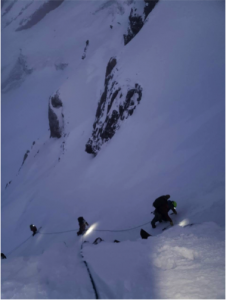
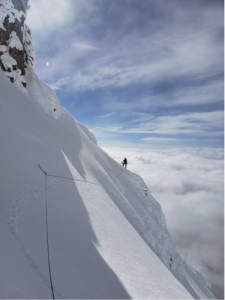
The alarm went off at 3:30AM the next day and we made a hot breakfast, sipped some coffee, and broke down the tents. The day started with a few hundred vertical feet of steep snow climbing, and then we built snow picket anchors for our first pitch of roped climbing as first light hit. As I put our assistant guide on-belay, the sun crested the horizon and I had my first “this is why I do these things” moment of the day. These moments come in waves, between the physical exhaustion of an endurance event with little oxygen and little sleep, and the monotony of moving one foot and then the next in an infinite rhythm. Eventually you get accustomed to the motions of the upward movement and it becomes almost routine, until a moment of absolute beauty pulls you out of it and takes your breath away all over again. This was the process that day – extreme fatigue, back pain, nausea, alongside the most beautiful landscapes I had ever seen in my life.
As we crested 18,000 feet my fatigue and pain grew, and by the time we reached the Nicolas Martínez summit, the first of four, I felt broken. We continued several hundred more feet to set up our camp between Nicolas Martínez and Politecnica. We reached our camp location, and as I sat down in the snow Carla put her arm around my shoulder, offering words of encouragement and telling me to rest as everyone set up the tents.
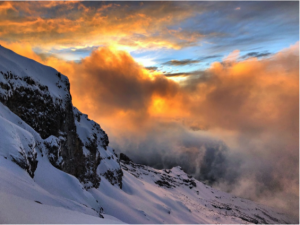

That night my fatigue and back pain grew, and Carla, Taylor and I had the tough conversation about what to do next. The nausea and headache were fairly “normal” for altitude, but my unanticipated debilitating nerve pain in my back was a wildcard. As a 6 person team with our assistant guide and two porters, we had the option of breaking up into two groups. In order to go down, though, I would need to continue several hundred more feet to the Politecnica summit and then descend a rarely traveled glacier, a journey that would take 8-12 hours to complete. Given the uncertainty of my back pain, I made the tough call to give up the final two summits, Whymper and Veintimilla, and head down the next day with the assistant guide and porter after achieving the Politecnica summit.
In the early morning we all gave each other some words of encouragement and headed up Politecnica, my last summit of the trip. We then began to navigate the glacier descent, keeping a tight rope between our team of three during the low-visibility predawn hours. Though I felt some disappointment in not completing the full traverse, I knew I had made the right call. Taylor and Carla would be able to make it to the summit, and my excitement for them was almost as great as it would have been had I made it myself. As the sun rose, the massive crevasses and seracs of the wild glacier came into view. We stopped for a snack as the sun illuminated the entire mountain, and I felt nothing other than joy and gratitude to be on that wild, magnificent glacier with my team.
At the end of the day, we all gathered in the beautiful Estrella de Chimborazo for dinner, and reflected on the trip. We talked about the beauty and the struggle of it all, and our gratitude for our time on the mountain and for our team.
The expedition was rounded off the next few days with “adventure-relaxation” – a mix of coffee and chocolate tasting, river rafting, paragliding, and delicious meals complimented by a great deal of conversation where we reflected back and looked forward to what’s to come. As I packed my bags and hugged Taylor and Carla goodbye, I struggled to keep back tears, and had to wish them a “see you later” instead of “goodbye.”
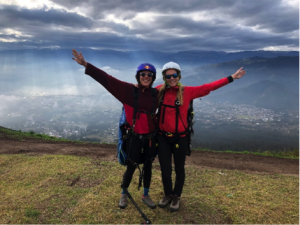 Coming away from this trip, I feel more empowered than ever to climb harder, and also more impassioned to bring other women and underrepresented groups into this sport. Women supporting women is one powerful way to help break some of the access and opportunity barriers for females in climbing. While I don’t plan to ditch all of my male climbing partners, I know that I’ll be contacting Alpenglow for more women’s climbs in the future, and I am grateful to have the opportunity to engage with a company who values these opportunities.
Coming away from this trip, I feel more empowered than ever to climb harder, and also more impassioned to bring other women and underrepresented groups into this sport. Women supporting women is one powerful way to help break some of the access and opportunity barriers for females in climbing. While I don’t plan to ditch all of my male climbing partners, I know that I’ll be contacting Alpenglow for more women’s climbs in the future, and I am grateful to have the opportunity to engage with a company who values these opportunities.